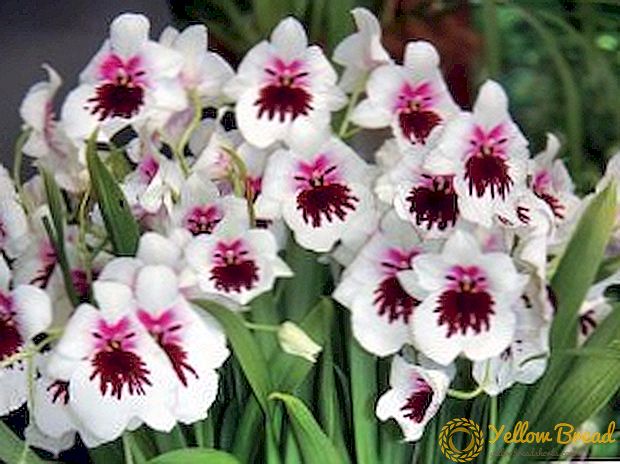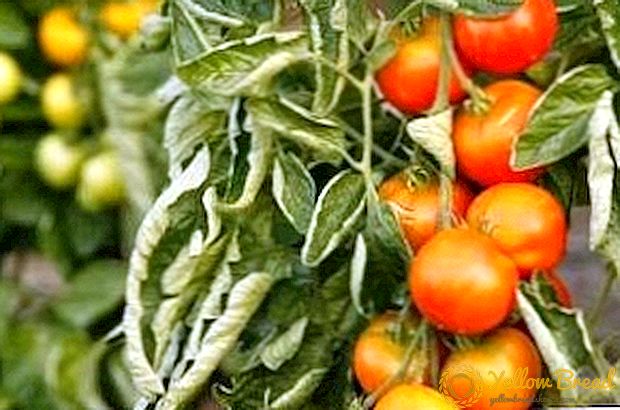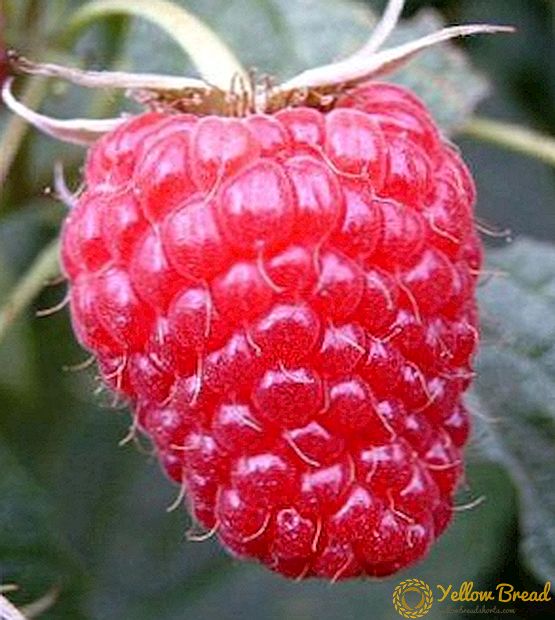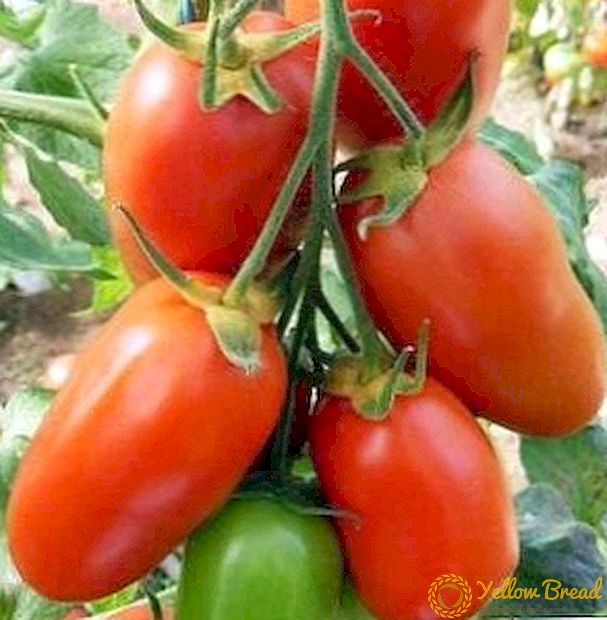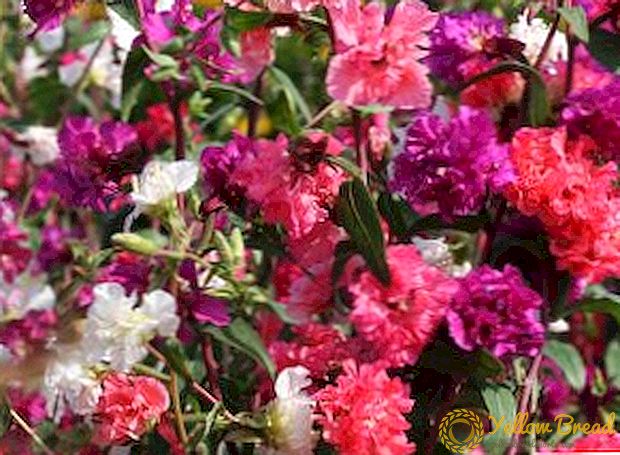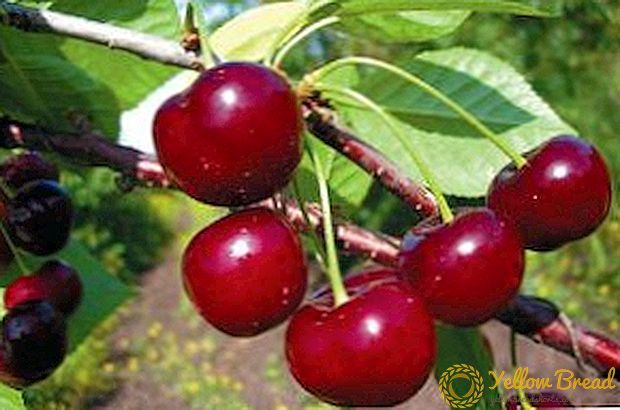 Probably, there is no such gardener who would not like to start a small garden on the plot, albeit a small one, but still.
Probably, there is no such gardener who would not like to start a small garden on the plot, albeit a small one, but still.
Often, this issue rests on the lack of space - the usual trees in a small area closely, and then more compact dwarf varieties help out. Many of them are unpretentious in care, besides they are pleased with good yields. Let's look at one such tree - dwarf cherry "Winter Pomegranate".
- Description of the bush
- Fruit Description
- Pollination
- Fruiting
- Gestation period
- Yield
- Winter hardiness
- Disease and Pest Resistance
- Application of fruits
Description of the bush
The variety has appeared relatively recently, but has already managed to give a good account of itself. The first seedlings that came to us were the result of breeding Canadian and sandy steppe cherries.
The result was an upright hybrid with neatly picked sprigs and 1.5–1.8 m high (on good soils it can grow up to 2 m) - this makes harvesting convenient.
Initially, the variety was created for growing in a continental climate with hot summers and frosty winters — in such conditions, the tree is best accepted.
Seedlings begin to bear fruit for 2-3 years after planting on an open area, then they also begin the first harvest.
 Note that this variety is considered decorative among dwarfs - abundant white and pink color pleases the eye in May, and in the second half of summer cute berries appear.
Note that this variety is considered decorative among dwarfs - abundant white and pink color pleases the eye in May, and in the second half of summer cute berries appear.Fruit Description
A description of a variety like Winter Pomegranate will be incomplete if you do not take into account the fruits of this dwarf cherry.
If you try to give them a characteristic, it will be like this:
- weight - 3.5-4 g;
- color - from ruby in appearance to deep burgundy, almost black, in ripe berries;
- bone - very small;
- the taste is sweet, with a noticeable sourness. Privetnosti and extra tartness is not observed;
- juice - bright red, slightly sour. It contains 14% sugar.
Such cherries have one more, especially practical, feature - they can hang on the branches until October, so you can not worry about safety, they will not fall off at once. 
Pollination
Variety refers to the self-fertile. That is, the absence of trees growing in the vicinity will not be a problem - the cross-pollination that is usual for many species does not play a special role here.
Moreover, 25-40% of the flowers that appeared in May become fruits independently, without the help of bees. True, this figure can be adjusted (affect the weather and conditions of the tree). 
Fruiting
In the third year after planting, the sapling begins to slowly bear fruit. The branches are densely dotted with small cherries.
From this moment until the fifth year of life, the tree continues the transition period - the fruits are already there, but full-bodied crops are rarely taken. At the peak of "performance" dwarf variety comes to 5-7 year growth.
Gestation period
The berries finally ripen by mid-August, when the ruby color of the fruit changes to a darker tone.
Some practice collecting already in the last decade of July, when the cherries have almost reached the desired size.This is not entirely correct - they taste too sour and the juice obtained from them will be the same.
It is better to wait another week or two until the fruits darken.
Yield
"Winter Pomegranate" stands out among other "dwarfs" also quite good fees. So, already in the third year, 4-6 kg of berries can be removed from one tree. After another 1-2 seasons, they get a more impressive return of 7-8 kg. 
6-8 growth seasons are considered the most productive, when the August harvest of cherries reaches 10 kg. If a tree growing on light, well-groomed soil grows up to 2 meters, there is every chance of taking even more - 12 kg from one plant is not such a rarity.
The collection process is facilitated by a small height and the ability of the fruit to hang on the branches for a long time.
Winter hardiness
Agronomists note that this variety calmly tolerates frosts down to -40 to -45 ° С without any shelter.
This is true - the line was displayed just for the long cold winters. But there are nuances: for example, such an "extreme" affects the yield (gardeners from the northern regions know about it on their own experience).  In addition to temperature, you need to remember about the amount of snow. If winters are cold and have little snow, then it is desirable to wrap the trunk. In the conditions of a more gentle European (moderate) winter, no unnecessary manipulations are required - the cherry will meet the spring without loss.
In addition to temperature, you need to remember about the amount of snow. If winters are cold and have little snow, then it is desirable to wrap the trunk. In the conditions of a more gentle European (moderate) winter, no unnecessary manipulations are required - the cherry will meet the spring without loss.
Disease and Pest Resistance
"Pomegranate" has an enviable immunity - a detached tree attack pests are not particularly scary. Risk factor may be the neighborhood with other trees (especially standard sizes). In such cases, some sores can still spread to the resistant "dwarf".
This applies to such problems as moniliosis (drying out), yellowing or falling off of fruits. They rarely occur, and if the disease is deeply struck near the garden.  For better protection against pests, prophylactic sprays are performed. Aphids will not appear if, before blooming buds, to treat the branches with "Olekupkrit", a little later fixing the result with "Phosphamide" or "Karbofos" (always before flowering).
For better protection against pests, prophylactic sprays are performed. Aphids will not appear if, before blooming buds, to treat the branches with "Olekupkrit", a little later fixing the result with "Phosphamide" or "Karbofos" (always before flowering).
The appearance of worms is excluded when processing insecticides of the type "Aktara".
Application of fruits
Harvested cherries can be consumed immediately after harvesting, fresh. Naturally, their use is not limited to this.
Fruits can be taken for:
- cooking compote;
- harvesting jam and various jams;
- production of homemade wine, liqueurs and tinctures.
We found out how interesting this unusual dwarf cherry is. We hope this information will help our readers to decide on the choice of "micro-tree", and the seedlings will delight record-breaking crops. Successes in the country! 

